Java MySQL 连接
本章节我们为大家介绍 Java 如何使用 使用 JDBC 连接 MySQL 数据库。
Java 连接 MySQL 需要驱动包,最新版下载地址为:http://dev.mysql.com/downloads/connector/j/,解压后得到jar库文件,然后在对应的项目中导入该库文件。
你可以下载本站提供的 jar 包:mysql-connector-java-5.1.39-bin.jar
本实例使用的是 Eclipse,导入 jar 包:
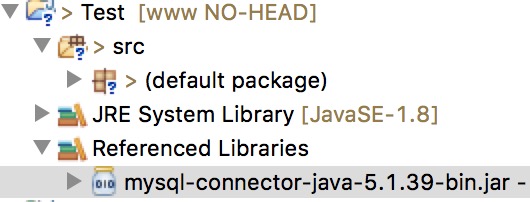
MySQL 8.0 以上版本的数据库连接有所不同:
1、MySQL 8.0 以上版本驱动包版本 mysql-connector-java-8.0.16.jar。
2、com.mysql.jdbc.Driver 更换为 com.mysql.cj.jdbc.Driver。
MySQL 8.0 以上版本不需要建立 SSL 连接的,需要显示关闭。
最后还需要设置 CST。
加载驱动与连接数据库方式如下:
Class.forName("com.mysql.cj.jdbc.Driver"); conn = DriverManager.getConnection("jdbc:mysql://localhost:3306/test_demo?useSSL=false&serverTimezone=UTC","root","password");
数据库数据
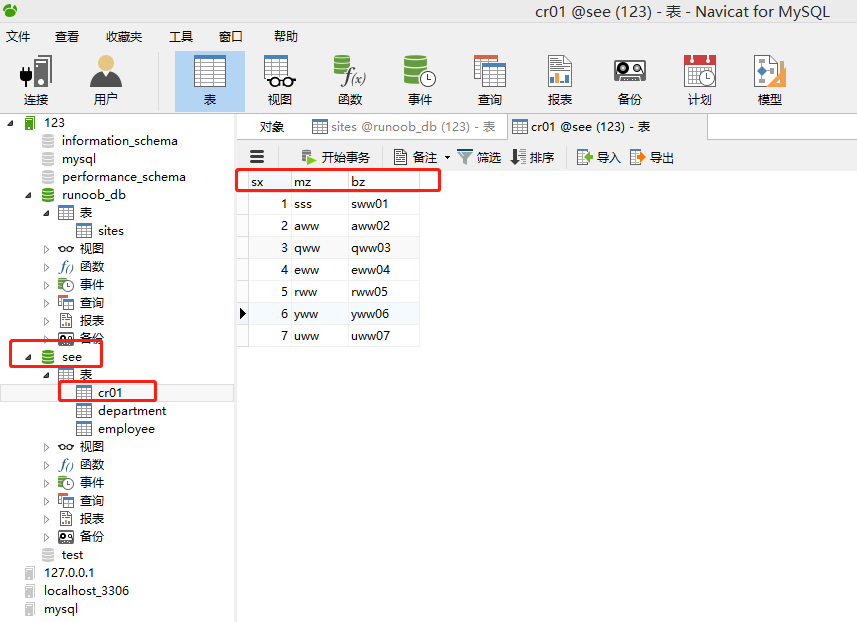
连接数据库
以下实例使用了 JDBC 连接 MySQL 数据库,注意一些数据如用户名,密码需要根据你的开发环境来配置:
package rjcs;
import java.sql.*;
public class lianjmysql
{
// MySQL 8.0 以下版本 - JDBC 驱动名及数据库 URL
static final String JDBC_DRIVER = "com.mysql.jdbc.Driver";
static final String DB_URL = "jdbc:mysql://localhost:3306/see";
// MySQL 8.0 以上版本 - JDBC 驱动名及数据库 URL
//static final String JDBC_DRIVER = "com.mysql.cj.jdbc.Driver";
//static final String DB_URL = "jdbc:mysql://localhost:3306/RUNOOB?useSSL=false&serverTimezone=UTC";
// 数据库的用户名与密码,需要根据自己的设置
static final String USER = "root";
static final String PASS = "123";
public static void main(String[] args) {
Connection conn = null;
Statement stmt = null;
try{
Class.forName(JDBC_DRIVER); // 注册 JDBC 驱动
System.out.println("连接数据库..."); // 打开链接
conn = DriverManager.getConnection(DB_URL,USER,PASS);
System.out.println(" 实例化Statement对象..."); // 执行查询
stmt = conn.createStatement();
String sql;
sql = "SELECT sx, mz, bz FROM cr01";
ResultSet rs = stmt.executeQuery(sql);
// 展开结果集数据库
while(rs.next()){
// 通过字段检索
int sx = rs.getInt("sx");
String mz = rs.getString("mz");
String bz = rs.getString("bz");
// 输出数据
System.out.print("ID: " + sx);
System.out.print(" , 名字: " + mz);
System.out.print(" , 不知: " + bz);
System.out.print("
");
}
// 完成后关闭
rs.close();
stmt.close();
conn.close();
}catch(SQLException se)
{
// 处理 JDBC 错误
se.printStackTrace();
}catch(Exception e)
{
// 处理 Class.forName 错误
e.printStackTrace();
}finally
{
// 关闭资源
try{
if(stmt!=null) stmt.close();
}catch(SQLException se2){
}// 什么都不做
try{
if(conn!=null) conn.close();
}catch(SQLException se){
se.printStackTrace();
}
}
System.out.println("Goodbye!");
}
}
执行结果:
连接数据库...
实例化Statement对象...
ID: 1 , 名字: sss , 不知: sww01
ID: 2 , 名字: aww , 不知: aww02
ID: 3 , 名字: qww , 不知: qww03
ID: 4 , 名字: eww , 不知: eww04
ID: 5 , 名字: rww , 不知: rww05
ID: 6 , 名字: yww , 不知: yww06
ID: 7 , 名字: uww , 不知: uww07
Goodbye!
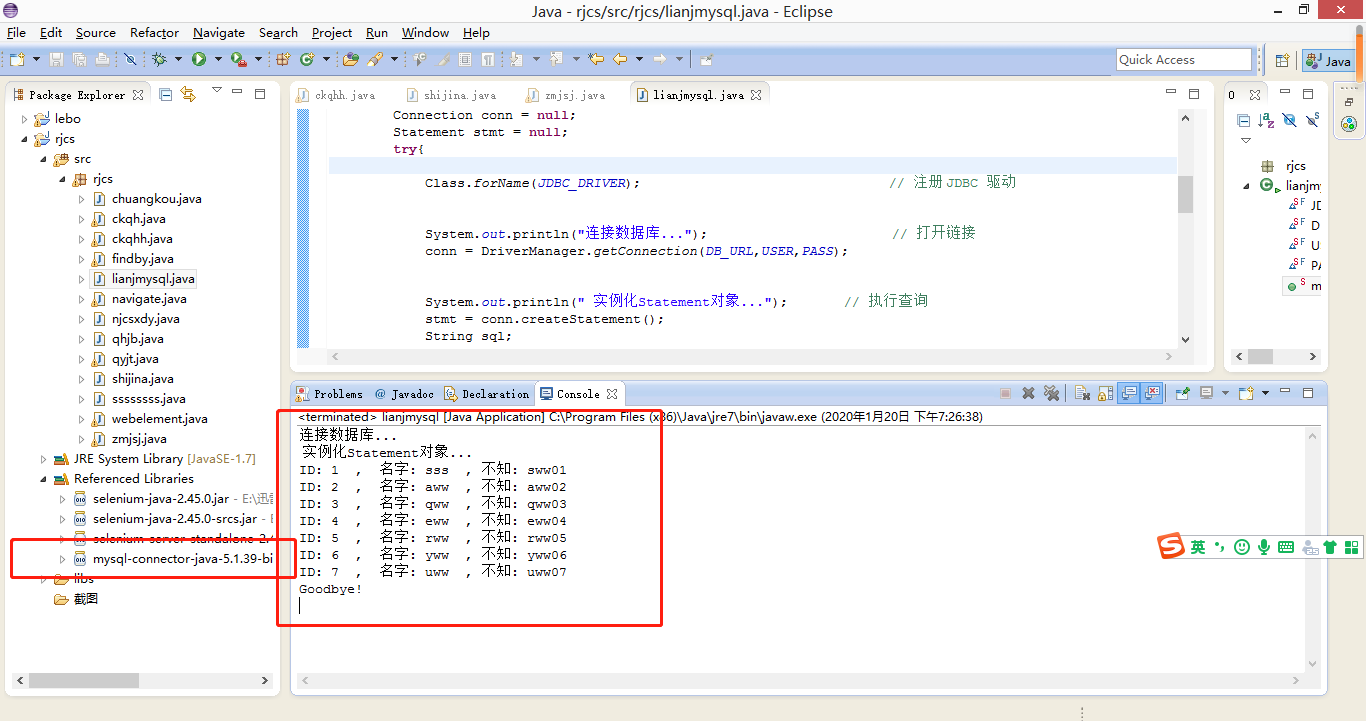
package rjcs;
import java.sql.*;
public class lianjmysql
{
// MySQL 8.0 以下版本 - JDBC 驱动名及数据库 URL
static final String JDBC_DRIVER = "com.mysql.jdbc.Driver";
static final String DB_URL = "jdbc:mysql://localhost:3306/see";
// MySQL 8.0 以上版本 - JDBC 驱动名及数据库 URL
//static final String JDBC_DRIVER = "com.mysql.cj.jdbc.Driver";
//static final String DB_URL = "jdbc:mysql://localhost:3306/RUNOOB?useSSL=false&serverTimezone=UTC";
// 数据库的用户名与密码,需要根据自己的设置
static final String USER = "root";
static final String PASS = "123";
public static void main(String[] args) {
Connection conn = null;
Statement stmt = null;
try{
Class.forName(JDBC_DRIVER); // 注册 JDBC 驱动
System.out.println("连接数据库..."); // 打开链接
conn = DriverManager.getConnection(DB_URL,USER,PASS);
System.out.println(" 实例化Statement对象..."); // 执行查询
stmt = conn.createStatement();
String sql;
sql = "SELECT sx, mz, bz FROM cr01";
ResultSet rs = stmt.executeQuery(sql);
// 展开结果集数据库
while(rs.next()){
// 通过字段检索
int sx = rs.getInt("sx");
String mz = rs.getString("mz");
String bz = rs.getString("bz");
// 输出数据
System.out.print("ID: " + sx);
System.out.print(" , 名字: " + mz);
System.out.print(" , 不知: " + bz);
System.out.print("
");
}
// 完成后关闭
rs.close();
stmt.close();
conn.close();
}catch(SQLException se){
// 处理 JDBC 错误
se.printStackTrace();
}catch(Exception e){
// 处理 Class.forName 错误
e.printStackTrace();
}finally{
// 关闭资源
try{
if(stmt!=null) stmt.close();
}catch(SQLException se2){
}// 什么都不做
try{
if(conn!=null) conn.close();
}catch(SQLException se){
se.printStackTrace();
}
}
System.out.println("Goodbye!");
}
}
================================================
SQL 语句是诸如update,insert的更新语句,应该用statement的execute()方法。
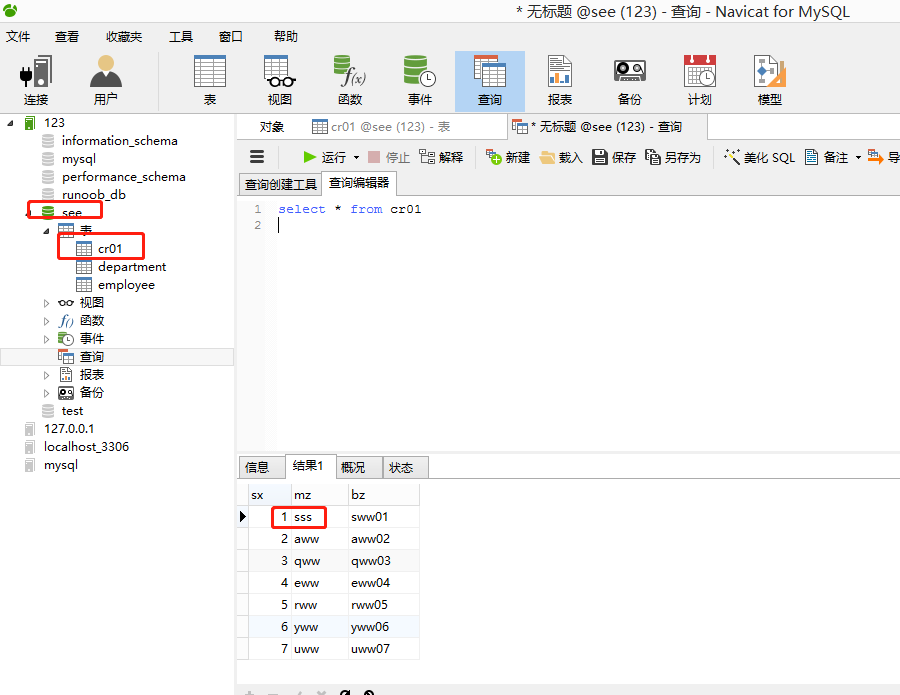
package rjcs;
import java.sql.*;
public class lianjmysql
{
// MySQL 8.0 以下版本 - JDBC 驱动名及数据库 URL
static final String JDBC_DRIVER = "com.mysql.jdbc.Driver";
static final String DB_URL = "jdbc:mysql://localhost:3306/see";
// MySQL 8.0 以上版本 - JDBC 驱动名及数据库 URL
//static final String JDBC_DRIVER = "com.mysql.cj.jdbc.Driver";
//static final String DB_URL = "jdbc:mysql://localhost:3306/RUNOOB?useSSL=false&serverTimezone=UTC";
// 数据库的用户名与密码,需要根据自己的设置
static final String USER = "root";
static final String PASS = "123";
public static void main(String[] args) {
Connection conn = null;
Statement stmt = null;
try{
Class.forName(JDBC_DRIVER); // 注册 JDBC 驱动
System.out.println("连接数据库..."); // 打开链接
conn = DriverManager.getConnection(DB_URL,USER,PASS);
System.out.println(" 实例化Statement对象..."); // 执行查询
stmt = conn.createStatement();
String sqlxg;
sqlxg = "update cr01 set mz = 'xxxxxx' where sx = 1";
stmt.execute(sqlxg);
String sql;
sql = "SELECT sx, mz, bz FROM cr01";
ResultSet rs = stmt.executeQuery(sql);
// 展开结果集数据库
while(rs.next()){
// 通过字段检索
int sx = rs.getInt("sx");
String mz = rs.getString("mz");
String bz = rs.getString("bz");
// 输出数据
System.out.print("ID: " + sx);
System.out.print(" , 名字: " + mz);
System.out.print(" , 不知: " + bz);
System.out.print("
");
}
// 完成后关闭
rs.close();
stmt.close();
conn.close();
}catch(SQLException se){
// 处理 JDBC 错误
se.printStackTrace();
}catch(Exception e){
// 处理 Class.forName 错误
e.printStackTrace();
}finally{
// 关闭资源
try{
if(stmt!=null) stmt.close();
}catch(SQLException se2){
}// 什么都不做
try{
if(conn!=null) conn.close();
}catch(SQLException se){
se.printStackTrace();
}
}
System.out.println("Goodbye!");
}
}
执行结果:
连接数据库...
实例化Statement对象...
ID: 1 , 名字: xxxxxx , 不知: sww01
ID: 2 , 名字: aww , 不知: aww02
ID: 3 , 名字: qww , 不知: qww03
ID: 4 , 名字: eww , 不知: eww04
ID: 5 , 名字: rww , 不知: rww05
ID: 6 , 名字: yww , 不知: yww06
ID: 7 , 名字: uww , 不知: uww07
Goodbye!

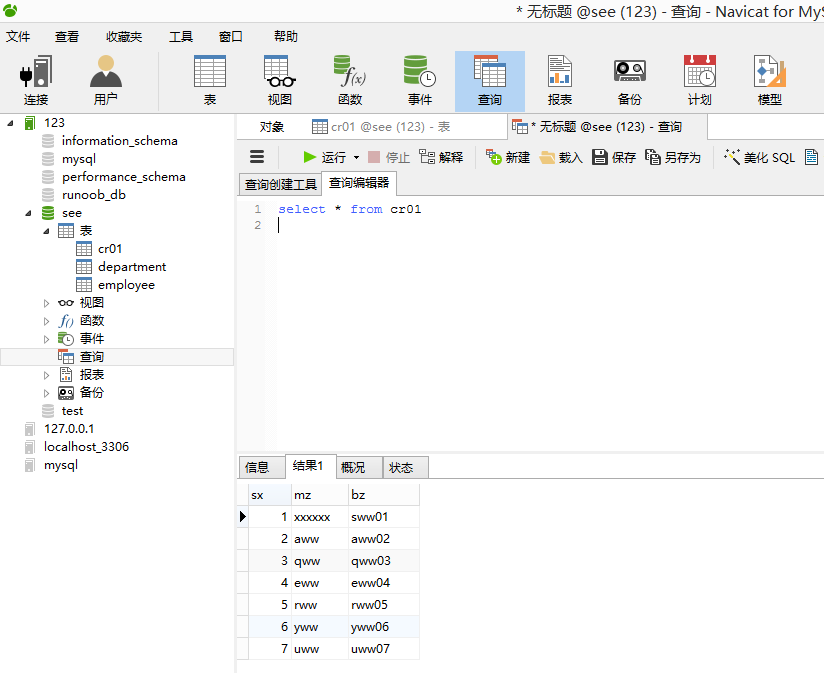
============================================
JDBC API 允许用户访问任何形式的表格数据,尤其是存储在关系数据库中的数据。
执行流程:
-
连接数据源,如:数据库。
-
为数据库传递查询和更新指令。
-
处理数据库响应并返回的结果。
JDBC 架构
分为双层架构和三层架构。
双层

作用:此架构中,Java Applet 或应用直接访问数据源。
条件:要求 Driver 能与访问的数据库交互。
机制:用户命令传给数据库或其他数据源,随之结果被返回。
部署:数据源可以在另一台机器上,用户通过网络连接,称为 C/S配置(可以是内联网或互联网)。
三层

侧架构特殊之处在于,引入中间层服务。
流程:命令和结构都会经过该层。
吸引:可以增加企业数据的访问控制,以及多种类型的更新;另外,也可简化应用的部署,并在多数情况下有性能优势。
历史趋势: 以往,因性能问题,中间层都用 C 或 C++ 编写,随着优化编译器(将 Java 字节码 转为 高效的 特定机器码)和技术的发展,如EJB,Java 开始用于中间层的开发这也让 Java 的优势突显出现出来,使用 Java 作为服务器代码语言,JDBC随之被重视。
JDBC 编程步骤
加载驱动程序:
Class.forName(driverClass)
//加载MySql驱动
Class.forName("com.mysql.jdbc.Driver")
//加载Oracle驱动
Class.forName("oracle.jdbc.driver.OracleDriver")
获得数据库连接:
DriverManager.getConnection("jdbc:mysql://127.0.0.1:3306/imooc", "root", "root");
创建StatementPreparedStatement对象:
conn.createStatement();
conn.prepareStatement(sql);
完整实例
import java.sql.Connection;
import java.sql.DriverManager;
import java.sql.ResultSet;
import java.sql.Statement;
public class DbUtil {
public static final String URL = "jdbc:mysql://localhost:3306/imooc";
public static final String USER = "liulx";
public static final String PASSWORD = "123456";
public static void main(String[] args) throws Exception {
//1.加载驱动程序
Class.forName("com.mysql.jdbc.Driver");
//2. 获得数据库连接
Connection conn = DriverManager.getConnection(URL, USER, PASSWORD);
//3.操作数据库,实现增删改查
Statement stmt = conn.createStatement();
ResultSet rs = stmt.executeQuery("SELECT user_name, age FROM imooc_goddess");
//如果有数据,rs.next()返回true
while(rs.next()){
System.out.println(rs.getString("user_name")+" 年龄:"+rs.getInt("age"));
}
}
}
增删改查
public class DbUtil {
public static final String URL = "jdbc:mysql://localhost:3306/imooc";
public static final String USER = "liulx";
public static final String PASSWORD = "123456";
private static Connection conn = null;
static{
try {
//1.加载驱动程序
Class.forName("com.mysql.jdbc.Driver");
//2. 获得数据库连接
conn = DriverManager.getConnection(URL, USER, PASSWORD);
} catch (ClassNotFoundException e) {
e.printStackTrace();
} catch (SQLException e) {
e.printStackTrace();
}
}
public static Connection getConnection(){
return conn;
}
}
//模型
package liulx.model;
import java.util.Date;
public class Goddess {
private Integer id;
private String user_name;
private Integer sex;
private Integer age;
private Date birthday; //注意用的是java.util.Date
private String email;
private String mobile;
private String create_user;
private String update_user;
private Date create_date;
private Date update_date;
private Integer isDel;
//getter setter方法。。。
}
//---------dao层--------------
package